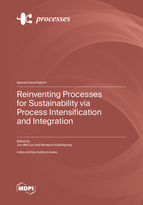Reinventing Processes for Sustainability via Process Intensification and Integration
A special issue of Processes (ISSN 2227-9717). This special issue belongs to the section "Sustainable Processes".
Deadline for manuscript submissions: closed (30 September 2023) | Viewed by 36810
Special Issue Editors
Interests: wastewater treatment process
Special Issues, Collections and Topics in MDPI journals
Interests: process intensification; biorefinery; bioresources; biofuels
Special Issues, Collections and Topics in MDPI journals
Special Issue Information
Dear Colleagues,
We would like to draw your attention to an Processes Special Issue titled “Reinventing Processes for Sustainability via Process Intensification and Integration”, publishing selected papers from the 2nd ICEIT 2021 jointly with SICTAS, scheduled to be published in 2020.
Selected papers from the 2nd International Conference on Engineering and Industrial Technology (http://www.iceitsu.org/Home/Home.aspx) in conjunction with the Silpakorn International Conference on Total Art and Science 2021 (http://www.sictas.org/Home/Home.aspx), to be held in Bangkok, Thailand on 3–5 November 2021 will be considered for this Special Issue.
The 2nd International Conference on Engineering and Industrial Technology 2021 (ICEIT 2021) is organized by the Faculty of Engineering and Industrial Technology, Silpakorn University, Thailand together with eight co-hosts: Chengdu University, China; National Institute of Technology, Toyota college, Japan; Yamaguchi University, Japan; Kumamoto University, Japan; Universiti Teknologi PETRONAS, Malaysia; Institute of Tropical Aquaculture and Fisheries (Akuatrop) of Universiti Malaysia Terengganu, Malaysia and Bio-Circular-Green-economy Technology & Engineering Center (BCGeTEC) and Center of Excellence on Catalysis and Catalytic Reaction Engineering (CECC) of Chulalongkorn University, Thailand; and the Electricity Generating Authority of Thailand.
In this year, the 2nd ICEIT 2021 will be held in conjunction with SICTAS 2021 on 3–5 November 2021 at Pathumwan Princess Hotel AND Bangkok Art and Culture Centre, Bangkok, Thailand. This is part of Reinventing University project granted by Ministry of Higher Education, Science, Research and Innovation, Thailand.
The 2nd ICEIT 2021 is a major international conference bringing together researchers, engineers, and practitioners who work in the areas of engineering and industrial technology with a wide spectrum of scientific themes, while the aim of SICTAS is to share and exchange experiences and research findings in all areas, including science and technology, art, and social science.
In this Special Issue, we seek to include comprehensive review papers, methodologies, experimental works, and modeling research articles that could improve our understandings from various disciplinary in processing of energy and natural resources. Potential topics include but are not limited to process intensification and integration for sustainable development, alternative and renewable energy, biomass energy, environment, catalytic reaction engineering, carbon capture and utilization (CCU), and climate change.
P.S.
After the 2nd ICEIT 2021 and SICTAS 2021 conferences, you are welcome to submit your full paper to this Processes Special Issue (Reinventing Process for Sustainability by Process Intensification and Integration, Selected papers from the 2nd ICEIT and SICTAS 2021). There is no need to wait for the submission deadline. All papers accepted for publication will be immediately published.
Dr. Jun-Wei Lim
Dr. Worapon Kiatkittipong
Guest Editors
Manuscript Submission Information
Manuscripts should be submitted online at www.mdpi.com by registering and logging in to this website. Once you are registered, click here to go to the submission form. Manuscripts can be submitted until the deadline. All papers will be peer-reviewed. Accepted papers will be published continuously in the journal (as soon as accepted) and will be listed together on the special issue website. Research articles, review articles as well as short communications are invited. For planned papers, a title and short abstract (about 100 words) can be sent to the Editorial Office for announcement on this website.
Submitted manuscripts should not have been published previously, nor be under consideration for publication elsewhere (except conference proceedings papers). All manuscripts are thoroughly refereed through a single-blind peer-review process. A guide for authors and other relevant information for submission of manuscripts is available on the Instructions for Authors page. Processes is an international peer-reviewed open access monthly journal published by MDPI.
Please visit the Instructions for Authors page before submitting a manuscript. The Article Processing Charge (APC) for publication in this open access journal is 2000 CHF (Swiss Francs). Submitted papers should be well formatted and use good English. Authors may use MDPI's English editing service prior to publication or during author revisions.
Keywords
- process intensification and integration
- biomass and bioresources
- chemical and pharmaceutical
- sustainability
- process development







